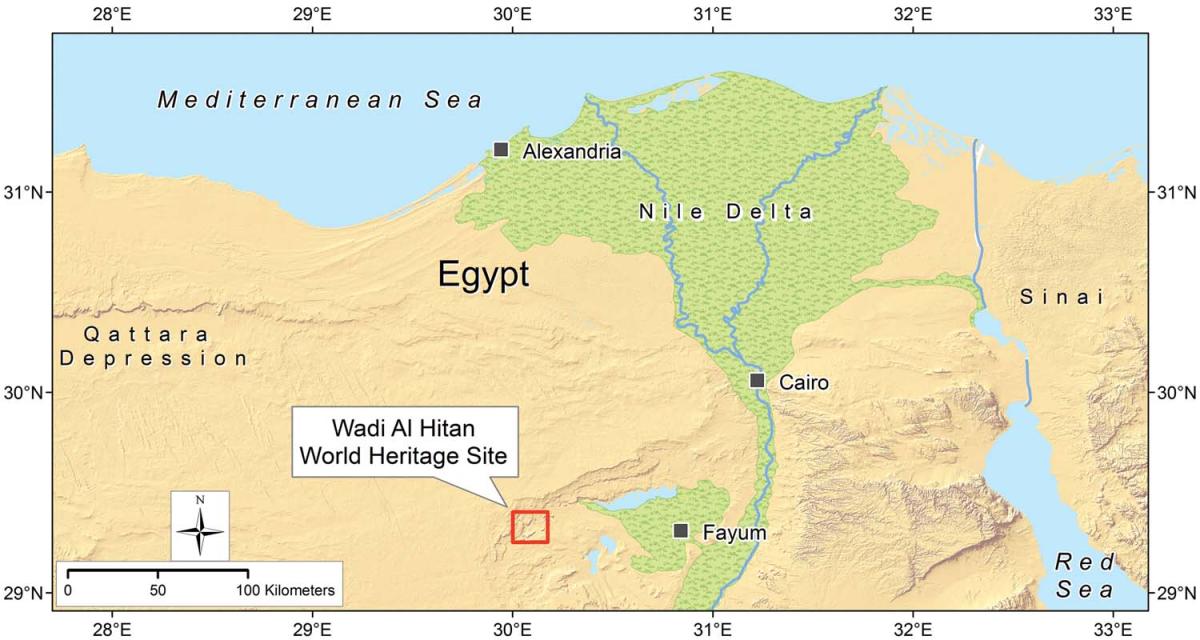In a study published in the open-access journal PLOS ONE, Manja Voss, a paleontologist at the Museum für Naturkunde Berlin, Germany, and colleagues describe the first direct evidence of diet in the fossil whale Basilosaurus isis from Wadi Al Hitan (“Valley of Whales”) in Egypt. Stomach contents of B. isis show that it fed on young calves of the contemporaneous smaller whale Dorudon atrox, suggesting that Basilosaurus was an apex predator in the late Eocene (~35 million years before present).
The Wadi Al Hitan UNESCO World Heritage Site was once a shallow sea and is well-known for its exceptional abundance of fossils, especially whales. A predator-prey relationship of the two most frequently found fossil whales in Wadi Al Hitan, the 15–18 meter long Basilosaurus isis and the 5-meter long Dorudon atrox, has long been hypothesized based on indirect evidence like bite marks on skulls of young D. atrox. On the basis of the new find, the authors complete the bigger paleoecological picture in the late Eocene of Egypt and identify B. isis as apex predator that lived at the top of an ecological pyramid.
A 16 meter long B. isis skeleton was recovered in December 2010 by an international team of researchers during a National Science Foundation-funded field campaign led by Prof. Philip D. Gingerich (University of Michigan). Most of the skeleton was preserved including the skull, teeth, vertebrae, ribs, and long bones of the limbs. During excavation, the paleontologists also found fragments of large bony fish, and, most importantly, remains of D. atrox calves in the body cavity of the B. isis skeleton. One D. atrox specimen was special in showing bite marks, which could be well attributed to the teeth of B. isis. The authors conclude that the large body size, long and powerful snout, pointed incisors, and sharp cheek teeth mark B. isis as a meat-eating top predator rather than a scavenger. Against the background that Wadi Al Hitan is interpreted as a calving area for Dorudon, the authors consider it as a perfect hunting site for B. isis that preferencially fed on young and small-sized dorudons.
The new find of B. isis helps us to understand the diverse interactions of organisms in a marine ecosystem and significantly extends our knowledge on the ecology of extinct whales and on the trophic levels within the ecological pyramid in ancient oceans in general. Ultimately, such findings help us to better understand and protect todays marine ecosystems.
This research study is the outcome of a collaboration of the first author Dr. Manja Voss (Museum für Naturkunde Berlin), Dr. Mohammed Sameh M. Antar (Department of Geology and Paleontology, Nature Conservation Sector, Egyptian Environmental Affairs Agency, Cairo), Dr. Iyad S. Zalmout and Prof. Philip D. Gingerich (both at Museum of Paleontology, University of Michigan, Ann Arbor, USA).
The article “Stomach contents of the archaeocete Basilosaurus isis: apex predator in oceans of the late Eocene” and will be published on January 9, 2019 in the journal PLOS ONE, available upon publication at: http://journals.plos.org/plosone/article?id=10.1371/journal.pone.0209021
